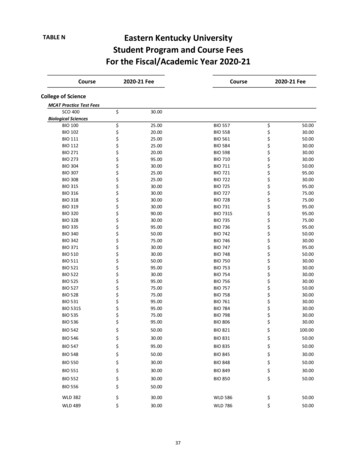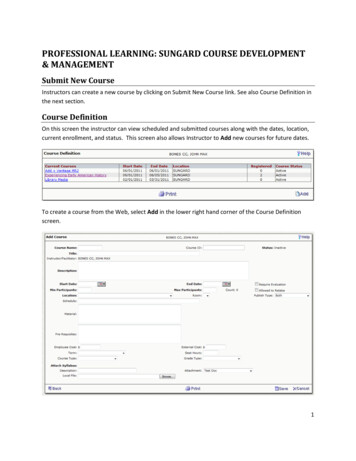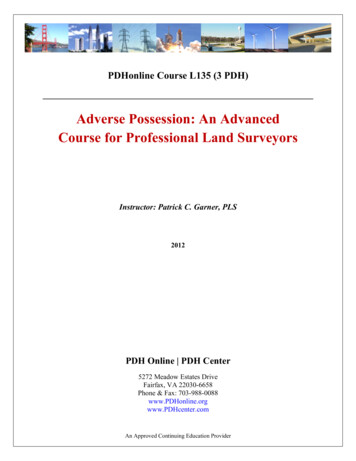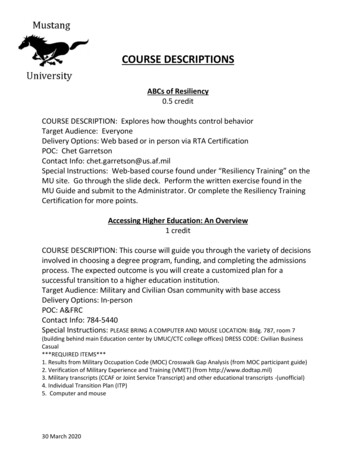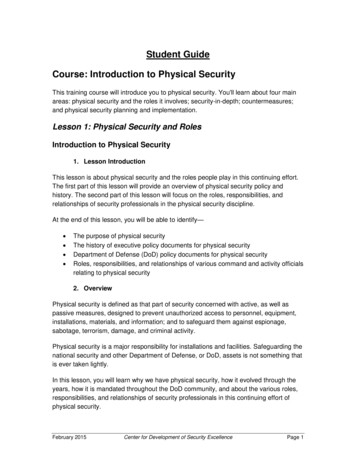
Transcription
Student GuideCourse: Introduction to Physical SecurityThis training course will introduce you to physical security. You'll learn about four mainareas: physical security and the roles it involves; security-in-depth; countermeasures;and physical security planning and implementation.Lesson 1: Physical Security and RolesIntroduction to Physical Security1. Lesson IntroductionThis lesson is about physical security and the roles people play in this continuing effort.The first part of this lesson will provide an overview of physical security policy andhistory. The second part of this lesson will focus on the roles, responsibilities, andrelationships of security professionals in the physical security discipline.At the end of this lesson, you will be able to identify— The purpose of physical securityThe history of executive policy documents for physical securityDepartment of Defense (DoD) policy documents for physical securityRoles, responsibilities, and relationships of various command and activity officialsrelating to physical security2. OverviewPhysical security is defined as that part of security concerned with active, as well aspassive measures, designed to prevent unauthorized access to personnel, equipment,installations, materials, and information; and to safeguard them against espionage,sabotage, terrorism, damage, and criminal activity.Physical security is a major responsibility for installations and facilities. Safeguarding thenational security and other Department of Defense, or DoD, assets is not something thatis ever taken lightly.In this lesson, you will learn why we have physical security, how it evolved through theyears, how it is mandated throughout the DoD community, and about the various roles,responsibilities, and relationships of security professionals in this continuing effort ofphysical security.February 2015Center for Development of Security ExcellencePage 1
Introduction to Physical SecurityPhysical Security and RolesStudent Guide3. Purpose of Physical SecurityThe two primary purposes of a physical security program are prevention and protection.Properly designed and executed physical security programs should deter or prevent, tothe greatest degree possible, the loss, theft, or damage to an asset.Our assets are our most critical resources and include personnel, information,equipment, facilities, activities, and operations. Combined, these assets are referred toas PIE-FAO. Deterrents such as guards, signs, dogs, and fences, typically providesufficient protection against general criminal activity.Because the United States of America now faces the possibility of terrorist threats like noother time in history, it is paramount that physical security be taken very seriously.4. History of Executive Policy DocumentsNow let's explore the history of executive policies for physical security. Physical securityhas been around since the beginning of mankind. There has always been a need for theprotection of one’s belongings. Through the years, the purpose of physical security haslargely remained the same to protect our assets. However, the methods used in thePhysical Security Program have changed significantly.In December 1952, President Truman signed an Executive Order which providedphysical security for facilities deemed important to the national defense mission.In September 1962, President Kennedy signed an Executive Order prescribingresponsibilities of the Office of Emergency Planning in the Executive Office of thePresident. Essentially, this order made directors of agencies responsible forinforming the President of what actions were necessary to physically protectfacilities and other assets to national security.In July 1979, President Jimmy Carter signed an Executive Order to establish theFederal Emergency Management Agency, or FEMA. This agency is charged withplanning for national emergencies.In November 1988, President Ronald Reagan signed an Executive Order thatassigned the responsibilities of preparedness for all of the DoD to the Chairmanof the Joint Chiefs of Staff, and the responsibility of antiterrorism and forceprotection to the Secretary of Defense.On September 11, 2001, the largest attack by terrorists in the U.S. occurred. Asa direct result of these terrorist attacks, the U.S. Congress passed, and PresidentBush signed the Homeland Security Act of 2002, creating the Department ofHomeland Security, or DHS.February 2015Center for Development of Security ExcellencePage 2
Introduction to Physical SecurityPhysical Security and RolesStudent GuideOn October 8, 2001, President George W. Bush signed Executive Order 13228,Establishing the Office of Homeland Security and the Homeland SecurityCouncil.On October 16, 2001, President George W. Bush signed Executive Order 13231,Critical Infrastructure Protection in the Information Age. This order ensures thephysical security of information systems for critical infrastructure, includingemergency preparedness communications, and the physical assets that supportsuch systems.On August 27, 2004, President Bush signed Homeland Security PresidentialDirective 12, or HSPD-12, Policy for a Common Identification Standard forFederal Employees and contractors. This requires government-widedevelopment and implementation of a standard for secure and reliable forms ofidentification for Federal employees and contractors.In February 2013, President Barack Obama signed Executive Order 13636,Improving Critical Infrastructure Cybersecurity, and Presidential Policy Directive21, or PPD-21, Critical Infrastructure Security and Resilience.The policies set forth in these directives are intended to strengthen the securityand resilience of critical infrastructure against evolving threats and hazards whilealso incorporating strong privacy and civil liberties protections into everycybersecurity initiative.These documents call for an updated and overarching national framework thatreflects the increasing role of cybersecurity in securing physical assets.If you are a history buff, you can use the table below to see how physical security hasevolved over the past several years.Event/E.O.DetailsHarry S. TrumanExecutive Order 10421 –Providing for the PhysicalSecurity of Facilities Importantto the National DefenseDecember 31, 1952February 2015Center for Development of Security ExcellencePage 3
Introduction to Physical SecurityPhysical Security and RolesStudent GuideEvent/E.O.DetailsJohn F. Kennedy(b) The Director, under authority of, and in accordancewith the provisions of, Executive Order No. 10421 ofDecember 31, 1952, shall perform functions in respect ofthe physical security of facilities important to the nationaldefense.Executive Order 11051 –Prescribing Responsibilities ofthe Office of EmergencyPlanning in the Executive Officeof the PresidentSeptember 27, 1962Jimmy CarterExecutive Order 12148 –Federal EmergencyManagementJuly 20, 1979Ronald ReaganExecutive Order 12656 –Assignment of EmergencyPreparedness Responsibilities(c) In addition, the Director shall review all measuresbeing taken by the Federal agencies with respect to thephysical security and protection of facilities important todefense mobilization, defense production, civil defense orthe essential civilian economy, including those under theprovisions of emergency preparedness assignments tosuch agencies and shall recommend to the Presidentsuch actions as are necessary to strengthen suchmeasures.Executive Order No. 10421, as amended, relating tophysical security of defense facilities is further amendedby (a) substituting the "Director of the FederalEmergency Management Agency" for "Director of theOffice of Emergency Planning" in Sections 1 (a), 1 (c),and 6 (b); and, (b) substituting "Federal EmergencyManagement Agency" for "Office of Emergency Planning"in Sections 6(b) and 7(b).(a) The policy of the United States is to have sufficientcapabilities at all levels of government to meet essentialdefense and civilian needs during any national securityemergency.November 18, 1988June 25, 1996 – KhobarTowers BombingIn 1996, the attack on U.S. forces housed in the KhobarTowers complex in Saudi Arabia, changed attitudes onthe protection of U.S. personnel from terrorist attack. Asa result of the Downing Commission Report, theSecretary of Defense accepted responsibility for antiterrorism/force protection (AT/FP) efforts within DoD, anddesignated the Chairman, Joint Chiefs of Staff (CJCS),as the focal point for all of DoD.September 11, 2001 –Terrorist Attacks on the U.S.The U.S. Congress passed and President Bush signedthe Homeland Security Act of 2002, creating theDepartment of Homeland Security, representing thelargest restructuring of the U.S. government incontemporary history.February 2015Center for Development of Security ExcellencePage 4
Introduction to Physical SecurityPhysical Security and RolesStudent GuideEvent/E.O.DetailsGeorge W. BushThe functions of the Office shall be to coordinate theexecutive branch’s efforts to detect, prepare for, prevent,protect against, respond to, and recover from terroristattacks within the United States.Executive Order 13228 –Establishing the Office ofHomeland Security and theHomeland Security CouncilOctober 8, 2001Executive Order 13231 –Critical Infrastructure Protectionin the Information AgeOctober 16, 2001Homeland SecurityPresidential Directive/HSPD12 – Policy for a CommonIdentification Standard forFederal Employees andContractorsPhysical Security, co-chaired by the designees of theSecretary of Defense and the Attorney General, tocoordinate programs to ensure the physical security ofinformation systems for critical infrastructure, includingemergency preparedness communications, and thephysical assets that support such systems. The standingcommittee shall coordinate its work with the Office ofHomeland Security and shall work closely with thePhysical Security Working Group of the Records Accessand Information Security Policy Coordinating Committeeto ensure coordination of efforts.The Directive requires the development and agencyimplementation of a mandatory, government-widestandard for secure and reliable forms of identification forFederal employees and contractors.August 27, 2004Barack ObamaExecutive Order 13636 –Improving Critical InfrastructureCybersecurityFebruary 2013Presidential Policy Directive21 – Critical InfrastructureSecurity and ResilienceThese directives are intended to strengthen the securityand resilience of critical infrastructure against evolvingthreats and hazards while also incorporating strongprivacy and civil liberties protections into everycybersecurity initiative.These documents call for an updated and overarchingnational framework that reflects the increasing role ofcybersecurity in securing physical assets.February 20135. DoD Policy DocumentsThere are several Department of Defense documents that govern physical security. Let’sdiscuss a few of those.February 2015Center for Development of Security ExcellencePage 5
Introduction to Physical SecurityPhysical Security and RolesStudent GuideFirst there is the DoD Instruction 5200.08, Security of DoD Installations and Resourcesand the DoD Physical Security Review Board (PSRB). This document authorizescommanders to issue regulations for the protection or security of property and placesunder their command. This document also establishes guidelines to build consistentminimum standards for protecting DoD installations and resources.There is also the DoD 5200.08-R, which is the Physical Security Program regulation.This document implements DoD policies and minimum standards for the physicalprotection of DoD personnel, installations, operations, and related resources.Another related DoD regulation is DoDM 5200.01, Volumes 1-4, the Information SecurityProgram regulation. This document addresses the physical security aspects ofprotecting classified information within the information security program.There are many other special categories that require physical protection not included inthis training. If you are involved in such programs, consult the appropriate guidance.DoD security is governed by many programs. As a security professional, there may betimes that you will need to refer to one of these documents for guidance. You do notneed to recall the names and numbers of each of these documents. However, youshould be aware of what information is available to guide you in the matters of physicalsecurity.Guidance Document NumberGuidance Document TitleDoDM 5100.76Physical Security of Sensitive Conventional Arms,Ammunition, and Explosives (AA&E)DoDI 5200.08Security of DoD Installations and Resources and the DoDPhysical Security Review Board (PSRB)DoD 5200.08-RPhysical Security ProgramDoDM 5200.01, Volumes 1-4DoD Information Security ProgramDoDD 5205.07Special Access ProgramDoDS 5210.41-MNuclear Weapon Security Manual: DoD Nuclear WeaponEnvironment-Specific Requirements (U)DoDI 5210.63DoD Procedures for Security of Nuclear Reactors and SpecialNuclear Materials (SNM)DoDI 5210.65Minimum Security Standards for Safeguarding ChemicalAgentsDoDI 5210.84Security of DoD Personnel Assigned to U.S. Missions AbroadICD 705Sensitive Compartmented Information FacilitiesDoDI 2000.12DoD Antiterrorism (AT) ProgramFebruary 2015Center for Development of Security ExcellencePage 6
Introduction to Physical SecurityPhysical Security and RolesStudent Guide6. SummarySo far, you have learned about the primary purpose, history, and Department of Defensepolicies, regulations, and directives that affect physical security. Physical security coversall of our government’s assets, to include personnel, information, equipment, facilities,activities, and operations. The two primary purposes of physical security are preventionand protection. As you proceed throughout this course, you will explore and examinethese principles in greater detail.February 2015Center for Development of Security ExcellencePage 7
Introduction to Physical SecurityPhysical Security and RolesStudent GuideReview Activity 1Fill in the blanks by placing each word in the correct sentence. Check your answers inthe Answer Key at the end of this Student Guide.A. PeopleThe two primary purposes of physical security are protectionand .C. ProtectionD. OperationsThe term PIE-FAO, which represents some of our mostcritical resources, stands for , information,equipment, facilities, activities, and .B. PreventionFebruary 2015The root purpose of physical security has been the samesince the beginning of mankind. That purpose is theof assets.Center for Development of Security ExcellencePage 8
Introduction to Physical SecurityPhysical Security and RolesStudent GuideRoles, Responsibilities, and Relationships1. Group RolesIt is important for you to be familiar with the various coordinating activities that play apart in the physical security of DoD assets. These groups include the AntiterrorismExecutive Committee, or ATEC, the Antiterrorism Working Group, or ATWG, theInformation System Owner, or ISO, the Staff Judge Advocate, and the Threat WorkingGroup, or TWG.Physical security is not about one entity taking care of everything, but rather severalcoordinating activities providing an integrated and coherent effort for the protection ofnational security and other DoD assets. Select each coordinating activity to see theroles, responsibilities, and relationships between these groups.a. ATWGATWG stands for Antiterrorism Working Group. This group is responsible forassessing requirements for physical security, recommending and developingpolicy, preparing planning documents, and conducting criticality, vulnerability,and risk assessments.b. ATECATEC stands for Antiterrorism Executive Committee. This executive-levelcommittee should meet at least semi-annually to develop and refine antiterrorismprogram guidance, policy, and standards and act upon recommendations of theAntiterrorism Working Group and Threat Working Group to determine resourceallocation priorities and mitigate or eliminate terrorism-related vulnerabilities.c. ISOThe Information System Owner, or ISO, is responsible for the security ofinformation systems. This person coordinates physical security measures anddevelops contingency plans for the protection of the information systems.d. Staff Judge AdvocateThe Staff Judge Advocate works closely with the Antiterrorism Officer and othersto ensure that security considerations are properly and legally incorporated.February 2015Center for Development of Security ExcellencePage 9
Introduction to Physical SecurityPhysical Security and RolesStudent Guidee. TWGTWG is also known as the Threat Working Group. This group is comprised of anAntiterrorism Officer, counterintelligence representative, law enforcementrepresentative, operations security officer, information operations representative,and a chemical, biological, radiological, nuclear, and high yield explosiverepresentative.Commanders of larger installations may choose to include more individuals intheir TWG. Local law enforcement agencies can also use their knowledge toassist the TWG.2. Individual RolesThe agencies and organizations that protect our national security and DoD assets arecomprised of individuals who play an important part in the mission of physical security.These individuals include the Installation Commander or Facility Director, theAntiterrorism Officer, or ATO; Counterintelligence, or CI, support personnel; local, stateand Federal law enforcement officials, the Operations Security, or OPSEC, Officer; andthe Physical Security Officer.a. Installation Commander/Facility DirectorInstallation Commanders or Facility Directors who serve in management orleadership positions are responsible for several aspects of physical security.These responsibilities include the safety and protection of the people andproperty under their command, the planning, forming, coordinating, andintegrating all physical security matters into their installation, and theidentification of mission essential capabilities.DoDI 5200.08 designates commanders to issue regulations for the protection andsecurity of property or places under their command. In addition, the instructionauthorizes the commander to take reasonably necessary and lawful measures tomaintain law and order and to protect installation personnel and property.b. Antiterrorism OfficerThe Antiterrorism Officer manages the installation or facility antiterrorismprogram. This program uses defensive measures to reduce the vulnerability ofindividuals and property from terrorist attacks. This person is valuable insupporting the physical security mission.February 2015Center for Development of Security ExcellencePage 10
Introduction to Physical SecurityPhysical Security and RolesStudent Guidec. CI Support PersonnelCI support personnel are vital to supporting the physical security mission. Theyare responsible for providing information on the capabilities, intentions, andthreats of our adversaries. They must pay particularly close attention to thoseadversaries associated with foreign intelligence entities. History has proven thatwe must always be vigilant.In addition, CI support personnel are there to provide valuable assessments ofcounterintelligence considerations in support of physical security programs.d. Law Enforcement OfficialsLocal, state, and Federal law enforcement officials are vital to the physicalsecurity program. Effective liaison with these officials fosters good workingrelationships so we can coordinate antiterrorism concerns and efforts,emergency response, and criminal incidents. Coordination activities supportmutual understanding of jurisdiction and authority.e. Operations Security (OPSEC) OfficerThe OPSEC Officer is an integral part of the physical security team. Theseindividuals facilitate the process for identifying critical information, identifyingthreats to specific assets, assessing vulnerabilities to assets, analyzing risk tospecific assets and to national security as a whole, and developingcountermeasures against potential threats to national security and other DoDassets.f.Physical Security OfficerThe Physical Security Officer is charged with managing, implementing, anddirecting physical security programs. This person may also be responsible for thedevelopment and maintenance of physical security plans, instructions,regulations, and standard policies and procedures. They may also coordinatewith local law enforcement agencies, antiterrorism officers, and loss preventionpersonnel.3. SummaryAs you have learned, there are many individuals who play an important part in themission of physical security. The installation commander, facility director, ATO,Counterintelligence Officer, law enforcement officials, OPSEC Officer, and PhysicalSecurity Officer are all links in a chain that is necessary to protect national security andother DoD assets.February 2015Center for Development of Security ExcellencePage 11
Introduction to Physical SecurityPhysical Security and RolesStudent GuideReview Activity 2Fill in the blanks by matching each word on the left to the sentence in which it belongs.Check your answers in the Answer Key at the end of this Student Guide.A. Law Enforcementis responsible for the installation’s antiterrorismprogram.is responsible for providing valuable informationon the capabilities, intentions, and threats of adversaries.analyzes threats to assets and theirvulnerabilities.must be integrated into our intelligence gatheringprocess so that they can be part of coordinating emergencyresponses and criminal incidents on a Federal installation.is charged with management, implementation,and direction of all physical security programs.B. Antiterrorism OfficerC. OPSEC OfficerD. CI SupportE. Security OfficerFebruary 2015Center for Development of Security ExcellencePage 12
Introduction to Physical SecurityPhysical Security and RolesStudent GuideAnswer KeyReview Activity 1A. PeopleBThe two primary purposes of physical security are protectionand prevention.C. ProtectionAD. OperationsDThe term PIE-FAO, which represents some of our mostcritical resources, stands for people, information, equipment,facilities, activities, and operations.B. PreventionCThe root purpose of physical security has been the samesince the beginning of mankind. That purpose is theprotection of assets.Bis responsible for the installation’s antiterrorismprogram.Dis responsible for providing valuable informationon the capabilities, intentions, and threats of adversaries.Canalyzes threats to assets and theirvulnerabilities.Amust be integrated into our intelligence gatheringprocess so that they can be part of coordinating emergencyresponses and criminal incidents on a Federal installation.Eis charged with management, implementation,and direction of all physical security programs.Review Activity 2A. Law EnforcementB. Antiterrorism OfficerC. OPSEC OfficerD. CI SupportE. Security OfficerFebruary 2015Center for Development of Security ExcellencePage 13
Student GuideCourse: Introduction to Physical SecurityLesson 2: Security-in-DepthSecurity-in-Depth1. Lesson IntroductionSecurity-in-depth is a determination by the senior agency official that a facility’s securityprogram consists of layered and complementary security controls sufficient to deter,detect, and document unauthorized entry and movement within the facility. This isaccomplished through the integration of active and passive complementary physicalsecurity measures.Security-in-depth employs security measures in levels or steps. The physical securitymeasures create layers of protection similar to the layers or rings of an onion. Differentassets may require different levels of protection. In this lesson, we’re going to look atthese levels and how they relate to your situation.Security requirements for classified contracts are stated in DoD 5220.22M, the NationalIndustrial Security Program Operating Manual, or NISPOM. Any additional securityrequirements levied upon a contractor must be specifically addressed in the contract.2. Threat, Vulnerabilities, and CriticalityThreat, vulnerabilities, and criticality are essential factors to look at when one isassessing security measures. Let’s look at each of these terms and what they mean.a. ThreatThreat is defined as the perceived imminence of intended aggression by acapable entity to harm a nation, a government, or its instrumentalities, such asintelligence, programs, operations, people, installations, or facilities. A threat canbe an indication, circumstance, or event with potential to cause loss of, ordamage to, an asset or capability.We never know when or where a threat may be made to our nation’s assets;therefore, it is of the utmost importance that we analyze our vulnerabilities andcriticality.February 2015Center for Development of Security ExcellencePage 1
Introduction to Physical SecuritySecurity-in-DepthStudent Guideb. VulnerabilityVulnerability is defined as a situation or circumstance that, if left unchanged, mayresult in the degradation, loss of life, or damage to mission-essential resources.Vulnerabilities are weaknesses that can be exploited by an adversary to gainaccess to, or information from, an asset.Vulnerabilities can be the result of a variety of factors, such as the way a buildingwas constructed, the location of people, equipment, operational practices andeven personal behavior.c. Criticality determinationCriticality determination is based on two things: an asset’s importance to nationalsecurity, and the effect of its partial or complete loss. Look at criticality this way:criticality looks at the importance of a part to the whole. If an asset is necessaryto an installation or facility’s mission, then that asset has a high level of criticality,and therefore is vulnerable to a threat.That means we must provide whatever layers of security necessary to protectthat asset. Finding this balance will help us to establish what is necessary toprotect that asset from a threat.3. Point vs. Area SecurityThis section will cover two applications of physical security principles—point security andarea security.a. Point SecurityPoint security is exactly how it sounds. If you are assigned to point security, youare guarding a specific asset or resource. Two good examples of point securityare the crown jewels and the original Constitution of the United States ofAmerica. There are guards standing directly in the space of these items, and thejewels and constitution are their respective primary responsibilities. On a militaryinstallation or secure Federal building, entry and exit locations are often guarded.This is also an example of point security.Now that you know what point security means, what do you think area securitymight mean?b. Area SecurityThis type of security is geared towards protecting an entire area of the installationor facility. The goal of area security is to try and consolidate as many assets asFebruary 2015Center for Development of Security ExcellencePage 2
Introduction to Physical SecuritySecurity-in-DepthStudent Guidepossible into one area. This is to intensify the protection efforts while maximizingthe effectiveness of response forces. It is important to remember that securityprofessionals employ both point and area security to protect national security andother Department of Defense, or DoD, assets from damage, loss, and theft.4. Integrating Protective SystemsThe protection of national security and other DoD assets is accomplished through theapplication of active and passive complementary security controls. This integration ofphysical security measures is also known as security-in-depth. The best way to describehow the integration of physical security measures works is to think of an onion and allthe layers it takes to get through to the center. As you begin to peel an onion, it takesmore of an effort to reach the center.Imagine a government facility and add barriers and guard posts with guards in them.Next, imagine a fence around the perimeter along with bright lights and appropriatesigns. The government building inside the fence also employs security measures, asthere will be guards and security screening equipment one must walk through to get intothe building.Notice the layers of security and how each one is a deterrent. If someone is able topenetrate any of these layers of security, it will take them time and energy to get throughto the next layer. That time is what enables our security to defend and defeat before ournational security or DoD asset is endangered.5. Crime PreventionCrime prevention is a goal. Through awareness, diligence, and the application of activeand passive security measures, we can expect to reduce the frequency and severity ofcrimes against persons and property. We cannot ignore the existence of workplaceviolence. Just because we work in DoD facilities, this does not make us immune toworkplace violence. Crime prevention also includes loss prevention. These crimesadversely affect our organizational resources and our ability to complete missions.Lesson SummarySecurity-in-depth is a concept that employs security measures in levels, or steps. Thephysical security measures create layers of protection, where different assets mayrequire different levels of protection. Based on the lessons we just learned, you shouldnow have a better understanding of what goes into security-in-depth. Let’s see if we canput it all together.The criticality of the assets is determined, and then the vulnerability of those assets isevaluated, based on the potential threat. It is important to remember that securityFebruary 2015Center for Development of Security ExcellencePage 3
Introduction to Physical SecuritySecurity-in-DepthStudent Guideprofessionals employ both point and area security to protect national security and otherDoD assets from damage, loss, and theft.The protection of national security and other DoD assets is accomplished through theapplication of active
Introduction to Physical Security Physical Security and Roles Student Guide February 2015 Center for Development of Security Excellence Page 2 3. Purpose of Physical Security The two primary purposes of a physical




